-
FRIEZE NEW YORK
-
-
-
-
-
-
-
-
-
-
-
-
-
-
-
-
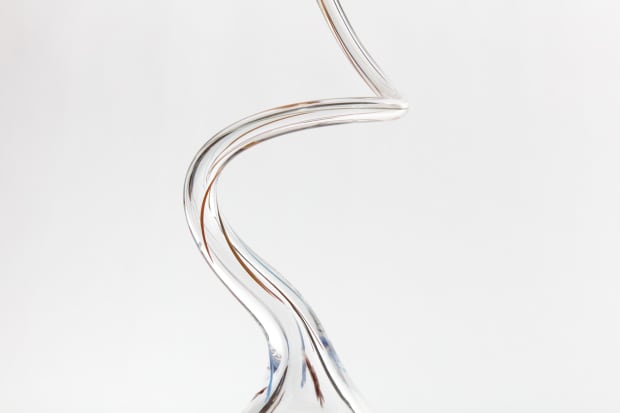
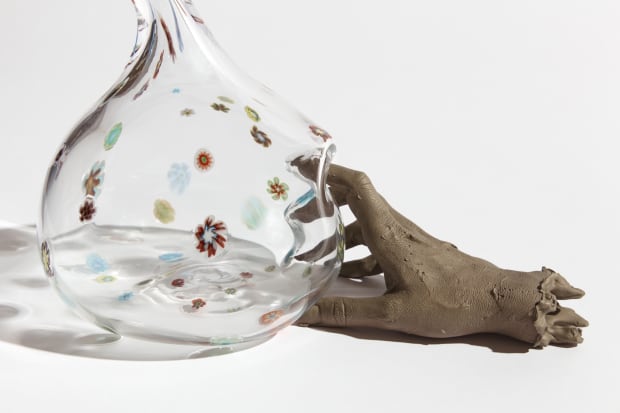
Material tactility, its possibilities, limitations, and transformation form the core of Kelly Akashi's practice. Originally trained in analog photography, traditional processes and the materiality of documents continue to inform and fuel her sculptural explorations. Working in a variety of media, such as wax, bronze, fire, glass, silicone, copper, and rope, Akashi investigates the capacity and boundaries of these elements and their ability to construct and challenge conventional concepts of form.
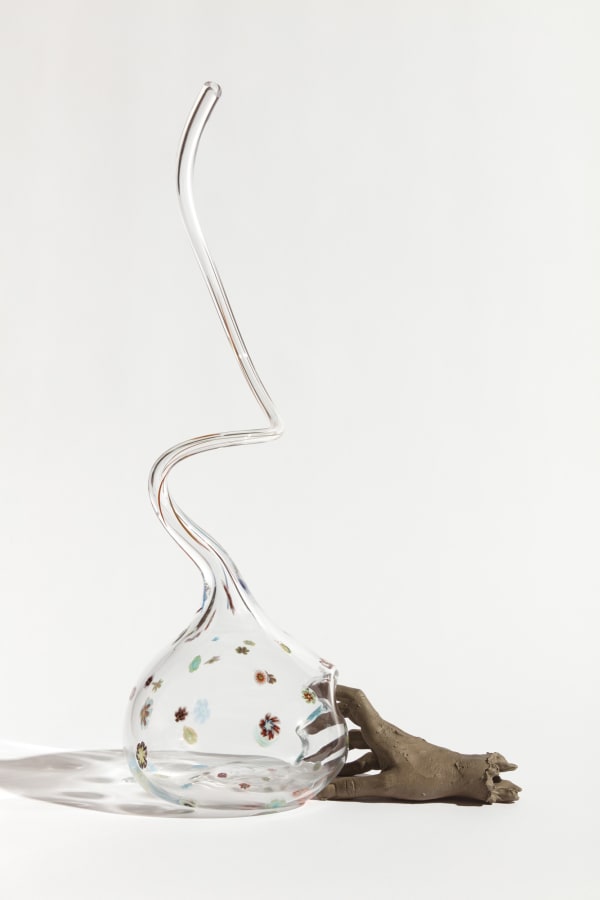
Kelly AKASHI
Life Forms
2021
Hand-blown glass, bronze
Overall dims: 24 x 15 x 9 inches; 61 x 38 x 23 cm
Bronze only: 4 x 9 x 4 inches; 10.2 x 23 x 10.2 cm
Glass only: 24 x 8 x 9 inches; 61 x 20.3 x 23 cm


Throughout her career, Sandra Cinto has developed a rich vocabulary of symbols and lines to create lyrical landscapes and narratives that hover between fantasy and reality. Using drawing as her point of departure, the artist renders intricate and mesmerizing environments of turbulent seascapes, violent rainstorms, and celestial skies that frequently engage with the surrounding architecture to a disorienting effect, creating the illusion of a weightless, spiraling universe. Evoking stories of human hardship and redemption, these fantastical landscapes serve as a metaphor for the human odyssey, while also pushing the limits and possibilities of drawing.
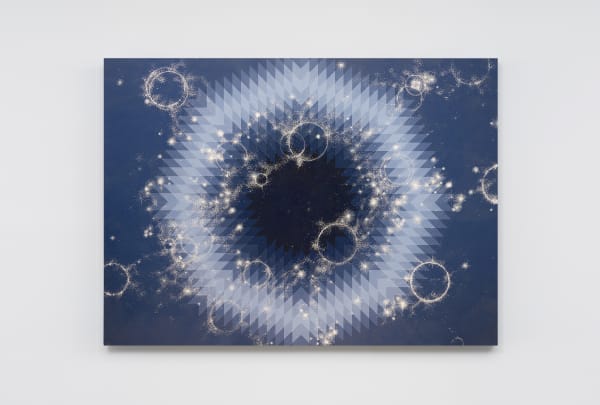
Sandra CINTO
21 Cosmic Rings
2021
Permanent pen and acrylic on canvas
75 x 102 3/8 x 1 3/4 inches; 190 x 260 x 4.5 cm

For Sandra Cinto, books are the most precious and powerful objects, providing an endless source of inspiration and freedom to all who are able to enjoy them. Her painted object in the form of a book continues her exploration of drawing as a way to capture the cosmic energy of the universe expressed through the lyrical landscape that hovers between fantasy and reality.

Sandra CINTO
Book V
2021
Acrylic on wood
7 7/8 x 5 1/2 x 1 3/8 inches; 20 x 14 x 3.5 cm


As the light in the center passes through color-effect filter glass panels it casts kaleidoscopic shadows on all of the surrounding surfaces, creating an immersive environment. The work functions both as an elegant autonomous sculpture and an encompassing light installation transforming the space it inhabits.
Currently, Olafur Eliasson has a major solo exhibition at the Fondation Beyeler, Life, on view until July 11, 2021.

Olafur ELIASSON
Glacial containment
2019
Colored glass (black, transparent), gold, stainless steel, paint (black), LED system
Diameter: 27 1/2 inches; 70 cm

Shimmering free-diving deep thought consists of colorful panes of hand-blown glass from which circular cutouts have been removed. The various panes of glass lean on one another and create a variety of hues where they overlap, allowing other tones to shine through the cutouts.The panes are supported by a single log of driftwood that was salvaged from the coast of Iceland. Since 2008 Eliasson has collected these large tree trunks from the beaches of northern Iceland, where the wood washes up from as far away as Siberia. Driftwood was long an important source of lumber in Iceland, where less than one per cent of the land is covered with forest. Here, the driftwood support has been planed into a shelf on one side and left raw on the other, revealing the traces of its long journey through the Arctic. This work is an extension of Eliasson’s long interest in color, transparency, and layering – topics he first began addressing in watercolor paintings, to which the glass works are closely related. Both groups of works use compositions of circles and ellipses to create a sense of movement and depth or of space and time.

Olafur ELIASSON
Shimmering free-diving deep thought
2019
Colored glass (orange fade, green, purple fade), silver, driftwood
42 1/8 x 31 1/2 x 4 3/4 inches; 107 x 80 x 12 cm

"WRKLT: believe" is included in Charles Long's current exhibition at Tanya Bonakdar Gallery, Los Angeles. Employing reflected light, Long combines the optical with the sculptural as fields of mirrored, crystalline growths sprout and redirect light into organized patterns appearing on proximate surfaces. These eruptions appear unsystematic, though they are faithfully precise to their purpose, as they angle their refraction to form cogent glyphs. Crafted by a process of merging the individual letters of a specific word into one symbol, these glyphs of light form what are historically known as sigils, where the maker maintains a state of mind where what would have been wished-for is known to already exist. In "WRKLT: believe", 2021, the sigil for the word ‘believe’ appears on the wall where the myriad light fragments can be seen as either assembling or in the process of disintegrating. The sculpture can be spun by the viewer so that the sigil disintegrates and scatters throughout the room, becoming stars on the ceiling. When the five reflective works are imagined all together, they form this sentence: ‘make believe our exile’s chosen,’ an advocation of the imagination as a pathway to find illumination in darkness.

Charles LONG
WRKLT: believe
2021
Plaster, dichroic glass paper mâché, steel, light, objects that found me
38 x 40 x 40 inches; 96.5 x 101.6 x 101.6 cm


Remarkable in execution and detail, Composition with Thin Blue Vertical was created within an intimate logic that has now become signature to Manders' practice. The work appears to be soft clay mid-way through the process of becoming a sculpture. The artist freezes a very specific moment in time, highlighting the fragility of every moment that passes. The manipulation of material generates a sense of puzzlement and awe, masterfully creating a sense of timelessness— while the sculpture seems to be just made, it is at the same time enigmatically atemporal.
Currently, Mark Manders has a major solo exhibition at Museum of Contemporarty Art, Tokyo, on view until June 20th, 2021.
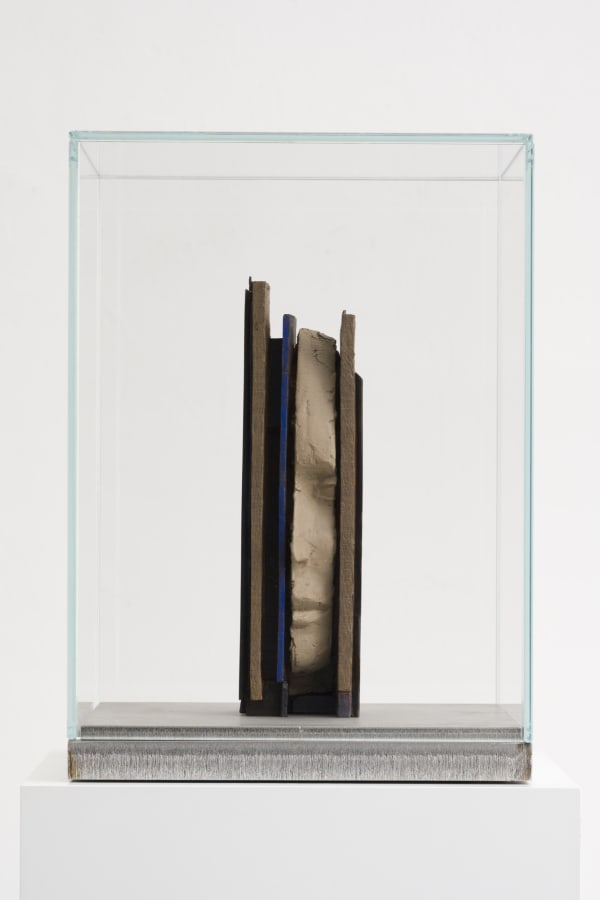
Mark MANDERS
Composition with Thin Blue Vertical
2020
Painted bronze, stainless steel, glass
17 x 12 1/4 x 12 1/4 inches; 43 x 31 x 31 cm overall
Edition of 3, 1 AP

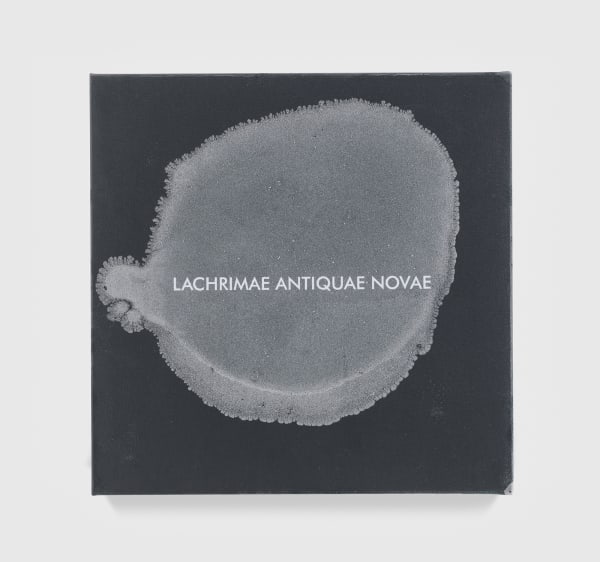
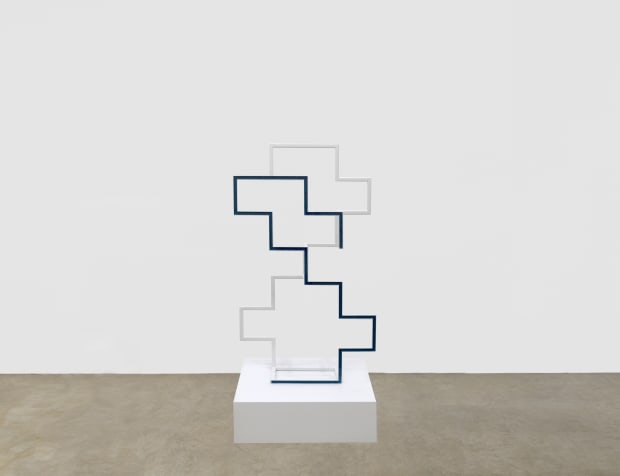

Sherrill Roland’s work 168.804, 2021, gives visual form to vivid memories of the ten months he spent wrongfully incarcerated. In this white steel sculpture, Roland recalls the experience of spending day after day in prison, when he would often pass the time by tracing the outlines of the white cinder blocks, which measured 8 x 16 x 8 inches and formed his two-man cell. Running his fingers horizontally and vertically, back and forth along the spaces between the blocks, he would take note of the difference in texture; the soft, smooth mortar contrasting sharply with the cold, hardness of the cinder blocks, providing a rare source of sensory stimulation. The repetitive, tactile action became a form of meditation that offered a mental escape to the freedom beyond the physical confines of the prison cell.
In 168.804, Roland recreates the idea of the soft area between cinder blocks by filling the steel channels with acrylic paint mixed with Kool- Aid, a beverage readily available in prison. This colorful, sweet drink brought back memories of Roland’s childhood when it was served at family gatherings to kids, a time of innocence which he often reflected upon during these moments of meditative escape. By tracing these areas around the cinder blocks, he was able to imagine leaving through the cracks and returning to the free world outside, demonstrating the power of touch and action to transport our minds elsewhere.

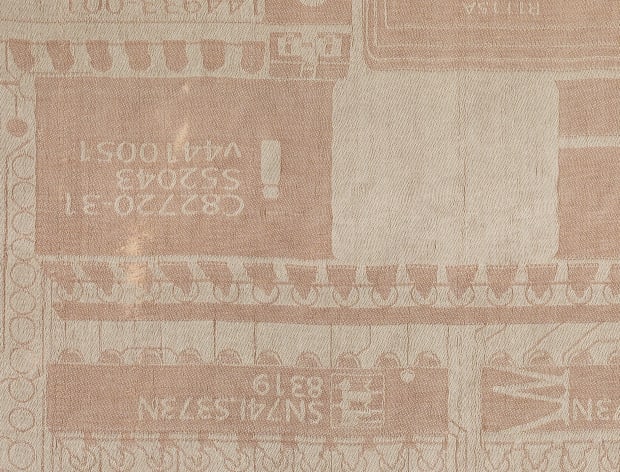

Copper Tapestry (iSBX 275 Graphics Card, Intel, 1983) is a continuation in a series of works where the artist introduces non-traditional materials into the process of tapestry weaving. Thin strips of copper traverse a linen warp to create an intricate design - a representation of an iconic 3D graphics card from the mid 1990s - a milestone in the development of computer graphics. More than two centuries ago, weaving production was accelerated by the improvements in technology possible through the Industrial Revolution, and Saban’s loom operates on a similar system. The artist's computerized loom operates following a binary code - and similarly the looms of yesteryear followed a comparable binary system. Saban’s choice of subject matter therefore is not coincidental. Complex computer systems that infiltrate many aspects of our daily lives rely on a basic programmed language that is, at its essence, not so dissimilar to the analogue language of weaving. And so the confluence of process and content comes to the fore - Saban’s tapestry, made using proto-digital technology, depicts a graphics card - the very advancement that translated computational information to images in a digital space. Saban here is interested in the pursuit of reality in the depictions of the world on a computer screen through persecutive and dimensionality - as always the artist is working at the edges of two and three dimensional space.
Analia Saban has a solo exhibition at Tanya Bonakdar Gallery, New York on through June 19, 2021.
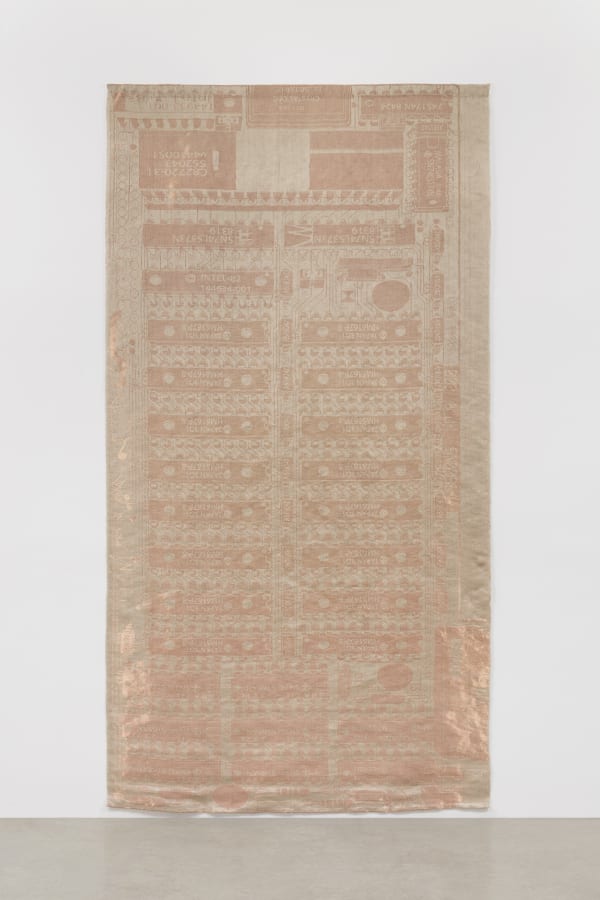
Analia Saban
Copper Tapestry (iSBX 275 Graphics Card, Intel, 1983)
2020
Woven copper wire and linen thread
133 1/2 x 71 x 1/16 inches; 339.1 x 180.3 x .2 cm

Printed Paint (Permanent Green Light / Color Mode: RGB (Red:22 – Green:255 – Blue:0)) is titled after the technical digital RGB color code and traditional paint color the work depicts. Saban uses an inkjet printer to ‘paint’ a color block onto a thin, fragmented layer of dried acrylic paint, which acts as paper. Emphasizing the automation of colors produced by a computer, the entire process of painting is digitalized. Creating an artificial representation of color, this programmed process is paired with hand-torn fragments that create compositions alluding to traditional landscape paintings.
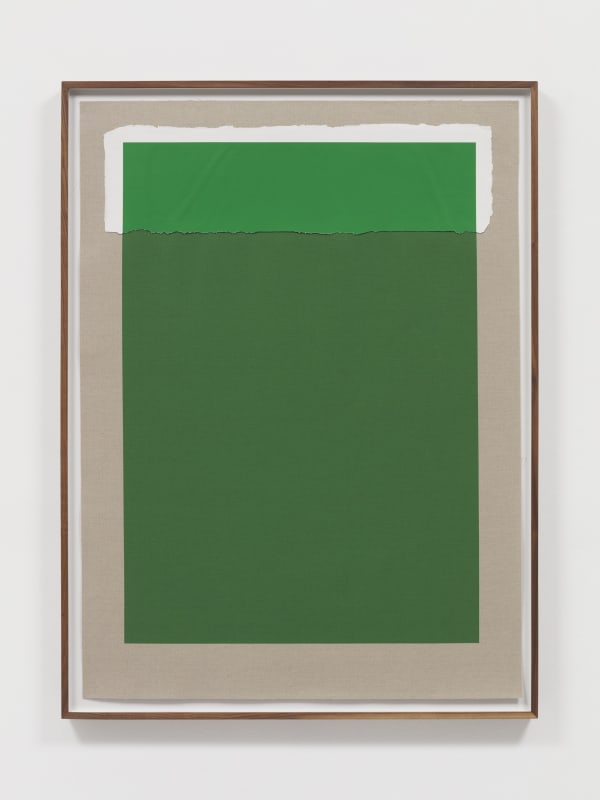
Analia Saban
Printed Paint (Permanent Green Light / Color Mode: RGB (Red:22 – Green:255 – Blue:0))
2021
Pigmented ink monoprint on Belgian linen and acrylic paint
52 x 39 x 2 inches; 132 x 99 x 5 cm (framed)
49 x 36 inches; 124.5 x 91.4 cm (unframed)


Composed of orbits held purely by their mutual tension, this sculpture examines the variations in speed and geometry of the trajectories of the celestial bodies and their relationship to one another in space and time. This work illustrates Saraceno’s fascination with naturally occurring systems of interconnectedness and constantly shifting structures, at once seemingly fragile, yet also a tightly coiled center for potential. Callisto 4.5 is titled after the second largest moon of Jupiter, which is about 4.5 times farther than Jupiter's closest large moon.

Tomás SARACENO
Callisto 4.5
2019
Glass disk, carbon fiber, polyester rope, velvet rope and monofilament
35 x 39 x 39 inches; 89 x 99 x 99 cm


Tomas SARACENO
HATS-3 b/M+M
2017
Powder coated stainless steel, polyester rope, fishing line, metal wire, steel thread, mirror panels
31 1/2 x 23 5/8 x 19 5/8 inches; 80 x 60 x 50 cm
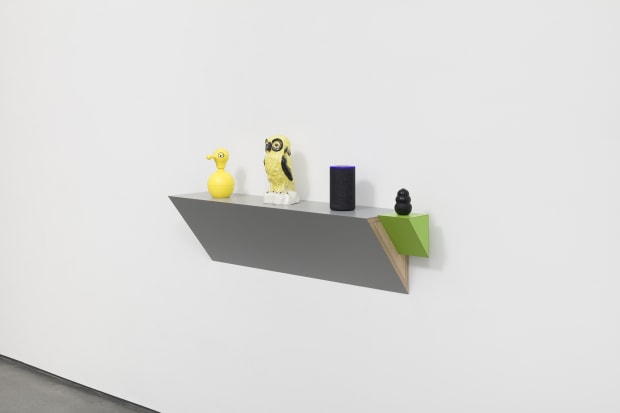
For more than four decades, Haim Steinbach has explored the psychological, aesthetic, cultural and ritualistic aspects of collecting and arranging already existing objects. His work engages the concept of “display” as a form that foregrounds objects, raising consciousness of the play of presentation. Steinbach selects and arranges objects – which range from the natural to the ordinary, the artistic to the ethnographic – thereby emphasizing their identities, inherent meanings and associations. An important influence in the growth of post-modern artistic dialogue, Steinbach’s work has radically redefined the status of the object in art.

Haim STEINBACH
Untitled (duck, owl, alexa, kong)
2019
Plastic laminated wood shelf; plastic soap dispenser; ceramic owl; Amazon Echo smart speaker; rubber dog chew
20 7/8 x 42 1/8 x 9 1/2 inches; 53 x 107 x 24.1 cm
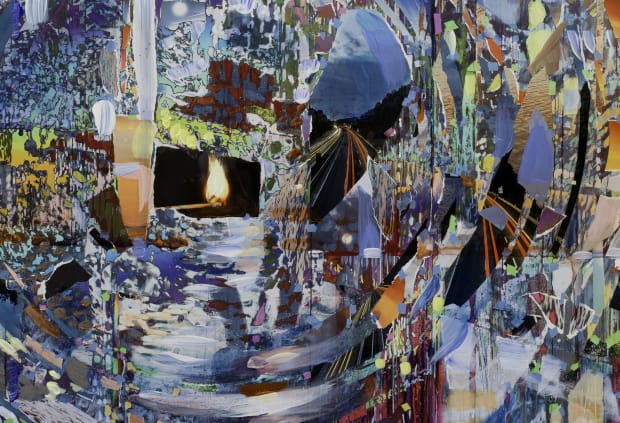

Through complex constellations of objects and a proliferation of images, Sze expands upon the never-ending stream of visual narratives that we negotiate daily, from magazines and newspapers, television and iPhones, to cyberspace and outer space. This work evokes the generative and recursive process of image-making in a world where consumption and production are more interdependent, where the beginning of one idea is the ending of another—and where sculpture gives rise to images, and images to sculpture. Sze expands her work by embedding her nuanced sculptural language into the material surfaces of a painting and into the digital realm through the interplay of cloth, ink, wood, paper, metal, paint, found objects, light, sound and structural supports—collapsing distinctions between two, three and four dimensions. Her practice fundamentally alters our sense of time, place, and memory by transforming our experiences of the physical world.
Sarah Sze has an exhibition and permanent commission opening at the Storm King Art Center this summer, June 12 - November 8, 2021.
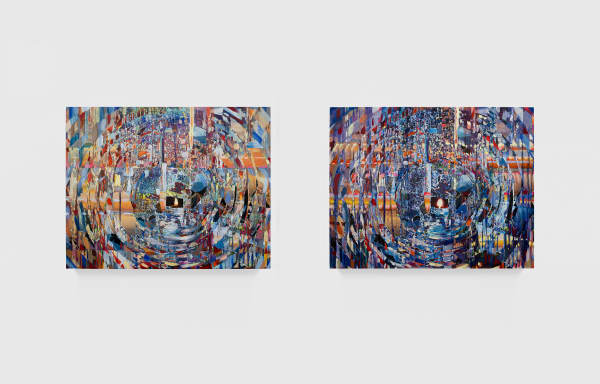
Sarah SZE
Focus at Dawn and Dusk
2021
Oil paint, acrylic paint, acrylic polymers, ink, aluminum, diabond and wood
16 x 20 inches; 40.6 x 50.8 cm (each panel)
16 x 40 inches; 40.6 x 101.6 cm (diptych)

Throughout the past two decades, Gillian Wearing’s films, photographs and sculptures have investigated public personas and private lives. The photographs, adding to her ongoing series of self- portraits that feature the artist dressed and masked as art historical figures who have been particularly influential to the artist's own practice. For Julia Margaret Cameron, Gillian positions her with two muses, touching on Wearing’s ongoing interest in identity and public versus private personas. The artist refers loosely to this series as her “spiritual family”.
This work will be included in Wearing’s upcoming exhibition at the Guggenheim in New York, on view November 5, 2021 - April 3, 2022.

Gillian WEARING
Me as Julia Margaret Cameron and two muses
2019
Bromide print, framed
60 x 46 1/4 inches; 152.4 x 117.5 cm (print)
63 1/2 x 49 3/4 inches; 161.2 x 126.3 cm (framed)
Edition of 6, 2APs